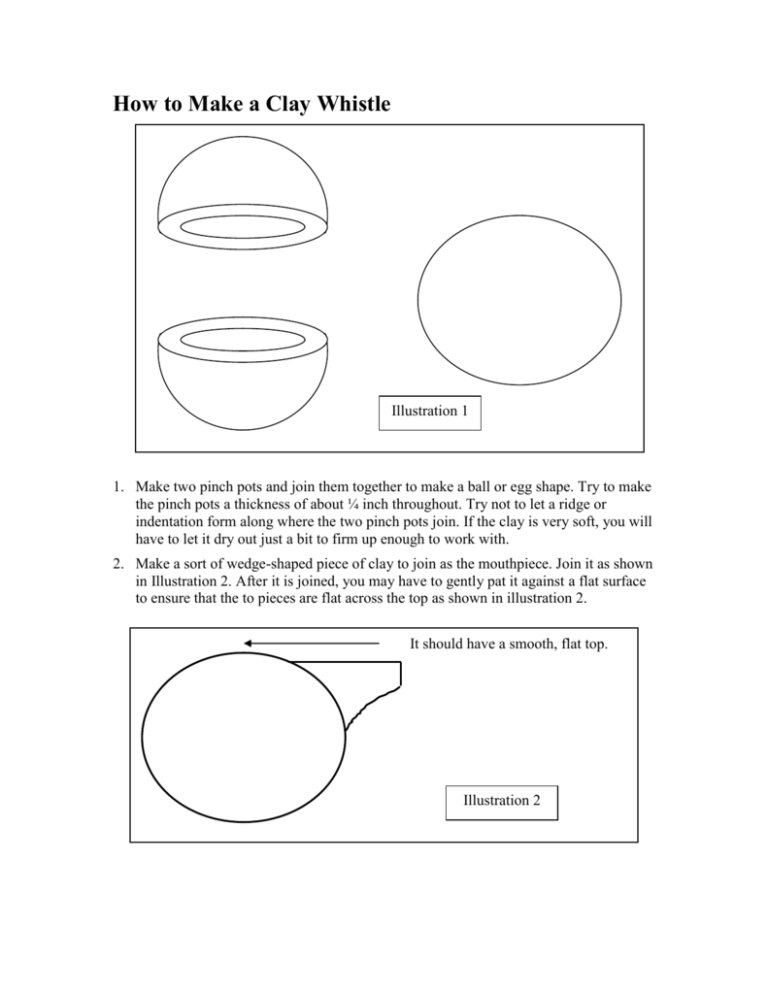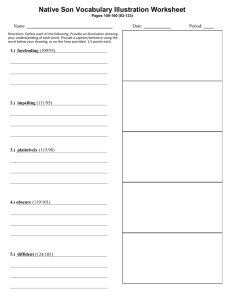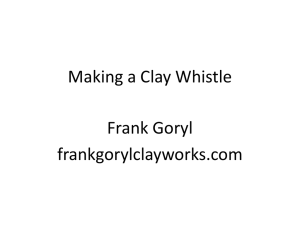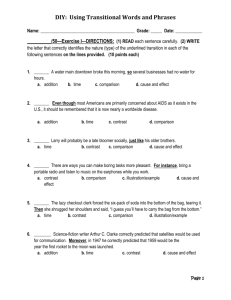How to Make a Clay Whistle
advertisement

How to Make a Clay Whistle Illustration 1 1. Make two pinch pots and join them together to make a ball or egg shape. Try to make the pinch pots a thickness of about ¼ inch throughout. Try not to let a ridge or indentation form along where the two pinch pots join. If the clay is very soft, you will have to let it dry out just a bit to firm up enough to work with. 2. Make a sort of wedge-shaped piece of clay to join as the mouthpiece. Join it as shown in Illustration 2. After it is joined, you may have to gently pat it against a flat surface to ensure that the to pieces are flat across the top as shown in illustration 2. It should have a smooth, flat top. Illustration 2 3. Just gently tap the whistle on a flat surface in order to achieve a nice flat surface for your airflow [Illustration 3]. Once you have the shape right, it is time to create the mouthpiece and the hole in such a way that it really makes a whistling sound. This is a very sensitive part of making the whistle, so follow along carefully. Illustration 3 4. Turn the whistle over so that you can look at the “top”. In these next steps, you will make a narrow passage for air to flow through and you will make a hole in the top. These must be done in a very precise manner. Look at Illustration 4 to see how the air should flow through the whistle. Air will pass through here. Illustration 4 5. Study Illustration 5 carefully. Use a narrow flat stick (I carve one from a balsa wood stick.) to gently push a passage through the mouthpiece. This is what it would look like if it were cut in half right down the middle. Illustration 5 6. Leaving the stick in the mouthpiece, hold your whistle so that you are looking down on it. You will need to get the placement of the hole in the top just right. Take a look at Illustration 6. This is where the hole should be placed. Be sure to notice the thickness of the clay and that the front of the hole should line up with the front, inside edge of the globe shaped whistle body. You will cut the hole here. Illustration 6 7. After you have cut a small rectangular hole in the top you can gently pull out the stick. You will use it again in a minute. 8. Using a rounded tool like a round pencil or thin marker, vertically lower it into the inside of your whistle through the hole in the top and gently roll it back and forth to flatten the front of the inner hollow as shown below in Illustration 7. [The places indicating the holes are gray.] Illustration 7 9. Insert the flattened stick back into the air passage hole. This helps to clear out the clay that clogs it back up while flattening the front. Now, you will see why it is important that you use a flat stick to make this hole. Keeping the stick inserted all of the way into the whistle as shown below, try to gently brace it steady while using the rounded stick to form a wedge on the other edge of the hole. See Illustration 8. The air flowing through the mouthpiece should point straight at the wedged back of the whistle hole. Illustration 8 10. The placement of the holes and the wedge are vital. You may have to go back and forth between steps 8 and 9 until you get a whistle sound. [By the way, you want to either wrap a piece of paper around the mouthpiece or wrap your fingers around it to blow through. Don’t get the clay on your mouth.] 11. Once you have achieved a whistle that makes a sound, stop, wrap it loosely in plastic and put it away until the next day. If you continue to blow into it, the moisture from your breath will cause it to cave in. Don’t forget to incise your initials into it if you are working with a group. You do want to know which one is yours.






